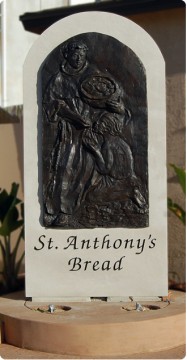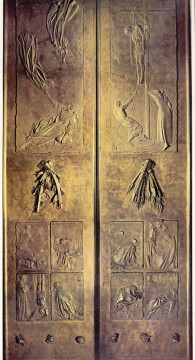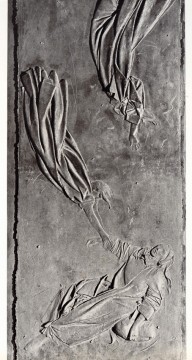 St. Anthony’s Bread is a bronze relief 5’x3′ on Indiana Limestone arch positioned in the front garden of the Franciscan Friary.
St. Anthony’s Bread is a bronze relief 5’x3′ on Indiana Limestone arch positioned in the front garden of the Franciscan Friary.
The arch is significant since St. Anthony, the wonder worker, lived and worked in Padua Italy. This city is known for its arches hence in this sculpture where we have the friar Anthony, in a large stride down the narrow streets of Padua, passing through the arches and emerging out from the stone.
St. Anthony’s chest is filled with a basket of bread which he passes on to the poor on the street. In this case a poor man kneeling to receive the bread almost as if receiving the Eucharist.
About the Sculpture’s artistic style
The artist, David Kocka’s style on relief sculpture such as “St. Anthony’s Bread” derives from the influence of a sculptor in Rome, Italy, who he met while studying there.
Giacamo Manzu created the “Doors of Death” (pictured below) at the Basilica of St. Peter’s in Rome. David would often go there and simply stare and study them; the relief moved him.
Like Giacomo Manzu’s style, David Kocka’s work tends toward the earthy and rough, coming out of a Franciscan heritage. It is low relief that tries to strike at the heart and not the mind. They become more contemplative pauses rather than refined and/or even pius classical stories. They are more poetry than prose. They have to be pondered over and after. They have to be lived with to become like a brother.
About the artist, David Kocka
David Kocka, born at the edge of the Mississippi in northern Minnesota has lived in Southern Indiana on the edge of the Ohio for 25 years. Kocka’s creative pilgrimage began in 1969 working under the tutelage of Paul T. Granlund. But while continuing his artistic studies in Europe, Kocka felt his old desire to be a monk and a priest return. Upon his return home and after almost a year of wrestling with that call he entered the Conventual Franciscan Order. Kocka was ordained a priest in 1983 and still pursued his art fulltime. In 1990, Kocka left the order and the active priesthood to marry. Now residing in the rural hills of Laconia in Southern Indiana on 140 acres of land he and his wife Judy have built a home, studio and foundry.


